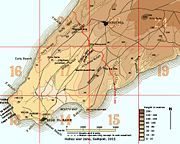
First Battle of Krithia
Encyclopedia
The First Battle of Krithia was the first Allied advance of the Battle of Gallipoli
during the First World War
. Starting at Helles
on 28 April, three days after the initial landings
, the attack broke down due to poor leadership and planning, lack of communications and exhaustion and demoralisation of the troops.
 On the morning of 25 April 1915, the British 29th Division
On the morning of 25 April 1915, the British 29th Division
under the command of Major General
Aylmer Hunter-Weston
landed on five beaches around Cape Helles at the southern tip of the Gallipoli
peninsula in the Ottoman Empire
. The main landings at 'V' and 'W' Beaches were hotly contested and the British suffered heavy casualties. A supporting landing made at 'Y' Beach on the Aegean
coast to the north was made without opposition but the troops were without instructions so made no attempt to either advance or dig in. At that time, the first-day objectives of the village of Krithia and the nearby hill of Achi Baba
were virtually undefended. When Ottoman reinforcements arrived the British were forced to evacuate the 'Y' Beach landing and so a major opportunity of early success was lost.
After heavy fighting, the British were able to secure the main landings. The French Corps expéditionnaire d'Orient division which had made a diversionary landing at Kum Kale on the Asian shore of the Dardanelles
on 25 April had now moved across the straits to Helles to hold the right of the Allied line. By the afternoon of 27 April, the Allies were able to make an advance of about two miles up the peninsula towards Krithia in readiness for an assault on the following day.
The ferocity of the Ottoman defence of the landings led the British to grossly overestimate the opposition they faced. Believing at the time that the Ottomans were indifferent fighters, they assumed they were faced by two divisions whereas in reality they outnumbered the Ottomans 3 to 1 and were confronted by two weak regiment
s who resisted doggedly while waiting for reinforcements.
and assailing Achi Baba from the south and west.
The overly-complex plan was poorly communicated to the brigade and battalion commanders of the 29th Division who would make the attack. Hunter-Weston remained far from the front; because of this, he was not able to exert any control as the attack developed.
The initial advances were easy but as pockets of Ottoman resistance were encountered, some stretches of the line were held up while others kept moving, thereby becoming outflanked. The further up the peninsula the troops advanced, the more difficult the terrain became, as they encountered the four great ravines that ran from the heights around Achi Baba towards the cape.
On the extreme left, the British ran into Gully Ravine which was as wild and confusing as the ground at Anzac Cove
. Two battalions of the 87th Brigade (1st Border Regiment and 1st Royal Inniskilling Fusiliers
) entered the ravine but were halted by a machine gun post near 'Y' Beach. No further advance would be made up the ravine until the 1st and 6th Gurkha Rifles
would capture the post on the night of 12–13 May. This involved them going up a 300 ft vertical slope which had defeated both the Royal Marine Light Infantry and the Royal Dublin Fusiliers. The site became knowning as 'Gurkha Bluff'.
The exhausted, demoralised and virtually leaderless British troops could go no further in the face of stiffening Ottoman resistance. In places, Ottoman counter-attacks would drive the British back to their starting positions. By 18:00 on 28 April, the attack was called off.
Battle of Gallipoli
The Gallipoli Campaign, also known as the Dardanelles Campaign or the Battle of Gallipoli, took place at the peninsula of Gallipoli in the Ottoman Empire between 25 April 1915 and 9 January 1916, during the First World War...
during the First World War
World War I
World War I , which was predominantly called the World War or the Great War from its occurrence until 1939, and the First World War or World War I thereafter, was a major war centred in Europe that began on 28 July 1914 and lasted until 11 November 1918...
. Starting at Helles
Cape Helles
Cape Helles is the rocky headland at the south-westernmost tip of the Gallipoli peninsula, Turkey. It was the scene of heavy fighting between Turkish and British troops during the landing at Cape Helles at the beginning of the Gallipoli Campaign in 1915....
on 28 April, three days after the initial landings
Landing at Cape Helles
The landing at Cape Helles was part of the amphibious invasion of the Gallipoli peninsula by British and French forces on April 25, 1915 during the First World War. Helles, at the foot of the peninsula, was the main landing area. With the support of the guns of the Royal Navy, a British division...
, the attack broke down due to poor leadership and planning, lack of communications and exhaustion and demoralisation of the troops.
Prelude

British 29th Division
The British 29th Division, known as the Incomparable Division, was a First World War regular army infantry division formed in early 1915 by combining various units that had been acting as garrisons about the British Empire. Under the command of Major General Aylmer Hunter-Weston, the division...
under the command of Major General
Major General
Major general or major-general is a military rank used in many countries. It is derived from the older rank of sergeant major general. A major general is a high-ranking officer, normally subordinate to the rank of lieutenant general and senior to the ranks of brigadier and brigadier general...
Aylmer Hunter-Weston
Aylmer Hunter-Weston
Lieutenant-General Sir Aylmer Gould Hunter-Weston KCB DSO GStJ was a British Army general who served in World War I at Gallipoli and the Somme Offensive...
landed on five beaches around Cape Helles at the southern tip of the Gallipoli
Gallipoli
The Gallipoli peninsula is located in Turkish Thrace , the European part of Turkey, with the Aegean Sea to the west and the Dardanelles straits to the east. Gallipoli derives its name from the Greek "Καλλίπολις" , meaning "Beautiful City"...
peninsula in the Ottoman Empire
Ottoman Empire
The Ottoman EmpireIt was usually referred to as the "Ottoman Empire", the "Turkish Empire", the "Ottoman Caliphate" or more commonly "Turkey" by its contemporaries...
. The main landings at 'V' and 'W' Beaches were hotly contested and the British suffered heavy casualties. A supporting landing made at 'Y' Beach on the Aegean
Aegean Sea
The Aegean Sea[p] is an elongated embayment of the Mediterranean Sea located between the southern Balkan and Anatolian peninsulas, i.e., between the mainlands of Greece and Turkey. In the north, it is connected to the Marmara Sea and Black Sea by the Dardanelles and Bosporus...
coast to the north was made without opposition but the troops were without instructions so made no attempt to either advance or dig in. At that time, the first-day objectives of the village of Krithia and the nearby hill of Achi Baba
Achi Baba
Achi Baba is a height dominating the Gallipoli Peninsula in Turkey.Achi Baba was the main position of the Ottoman Turkish defenses in 1915 during the World War I Gallipoli campaign.-References:...
were virtually undefended. When Ottoman reinforcements arrived the British were forced to evacuate the 'Y' Beach landing and so a major opportunity of early success was lost.
After heavy fighting, the British were able to secure the main landings. The French Corps expéditionnaire d'Orient division which had made a diversionary landing at Kum Kale on the Asian shore of the Dardanelles
Dardanelles
The Dardanelles , formerly known as the Hellespont, is a narrow strait in northwestern Turkey connecting the Aegean Sea to the Sea of Marmara. It is one of the Turkish Straits, along with its counterpart the Bosphorus. It is located at approximately...
on 25 April had now moved across the straits to Helles to hold the right of the Allied line. By the afternoon of 27 April, the Allies were able to make an advance of about two miles up the peninsula towards Krithia in readiness for an assault on the following day.
The ferocity of the Ottoman defence of the landings led the British to grossly overestimate the opposition they faced. Believing at the time that the Ottomans were indifferent fighters, they assumed they were faced by two divisions whereas in reality they outnumbered the Ottomans 3 to 1 and were confronted by two weak regiment
Regiment
A regiment is a major tactical military unit, composed of variable numbers of batteries, squadrons or battalions, commanded by a colonel or lieutenant colonel...
s who resisted doggedly while waiting for reinforcements.
Battle
The battle commenced around 08:00 on 28 April with a naval bombardment. The plan of advance was for the French to hold position on the right while the British line would pivot, capturing KrithiaKrithia
Krithia is a small Turkish village in the Eceabat District ofÇanakkale Province, Turkey, about 4 miles from the tip of the Gelibolu Peninsula....
and assailing Achi Baba from the south and west.
The overly-complex plan was poorly communicated to the brigade and battalion commanders of the 29th Division who would make the attack. Hunter-Weston remained far from the front; because of this, he was not able to exert any control as the attack developed.
The initial advances were easy but as pockets of Ottoman resistance were encountered, some stretches of the line were held up while others kept moving, thereby becoming outflanked. The further up the peninsula the troops advanced, the more difficult the terrain became, as they encountered the four great ravines that ran from the heights around Achi Baba towards the cape.
On the extreme left, the British ran into Gully Ravine which was as wild and confusing as the ground at Anzac Cove
Anzac Cove
Anzac Cove is a small cove on the Gallipoli peninsula in Turkey. It became famous as the site of World War I landing of the ANZAC on April 25, 1915. The cove is a mere long, bounded by the headlands of Ari Burnu to the north and Little Ari Burnu, known as Hell Spit, to the south...
. Two battalions of the 87th Brigade (1st Border Regiment and 1st Royal Inniskilling Fusiliers
Royal Inniskilling Fusiliers
The Royal Inniskilling Fusiliers was a Irish infantry regiment of the British Army formed in 1881 by the amalgamation of the 27th Regiment of Foot and the 108th Regiment of Foot...
) entered the ravine but were halted by a machine gun post near 'Y' Beach. No further advance would be made up the ravine until the 1st and 6th Gurkha Rifles
Gurkha Rifles
Gurkha Rifles may refer to any of a number of regiments of Gurkhas:* 1st King George V's Own Gurkha Rifles * 2nd King Edward VII's Own Gurkha Rifles * 3rd Queen Alexandra's Own Gurkha Rifles...
would capture the post on the night of 12–13 May. This involved them going up a 300 ft vertical slope which had defeated both the Royal Marine Light Infantry and the Royal Dublin Fusiliers. The site became knowning as 'Gurkha Bluff'.
The exhausted, demoralised and virtually leaderless British troops could go no further in the face of stiffening Ottoman resistance. In places, Ottoman counter-attacks would drive the British back to their starting positions. By 18:00 on 28 April, the attack was called off.

